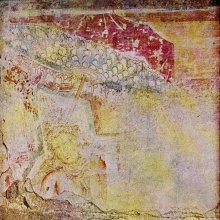Tribhuvana, Tri-bhuvana: 16 definitions
Introduction:
Tribhuvana means something in Hinduism, Sanskrit, Jainism, Prakrit, Marathi. If you want to know the exact meaning, history, etymology or English translation of this term then check out the descriptions on this page. Add your comment or reference to a book if you want to contribute to this summary article.
Images (photo gallery)
In Hinduism
Kavya (poetry)
Source: Wisdom Library: KathāsaritsāgaraTribhuvana (त्रिभुवन) is the name of an ancient king from Tribhuvana according to the Kathāsaritsāgara, chapter 56. Accordingly, as Tribhuvana said to Saṅgamadatta: “... I am a king named Tribhuvana, in the city of Tribhuvana. There a certain Pāśupata ascetic for a long time paid me court. And being asked the reason by me, he at once asked me to be his ally in obtaining a sword concealed in a cavern, and I agreed to that”.
The story of Tribhuvana was narrated by Saṅgamadatta to queen Bandhumatī in order to demonstrate that “doers of righteous actions eventually obtain reunion with loved ones”.
The Kathāsaritsāgara (‘ocean of streams of story’), mentioning Tribhuvana, is a famous Sanskrit epic story revolving around prince Naravāhanadatta and his quest to become the emperor of the vidyādharas (celestial beings). The work is said to have been an adaptation of Guṇāḍhya’s Bṛhatkathā consisting of 100,000 verses, which in turn is part of a larger work containing 700,000 verses.

Kavya (काव्य, kavya) refers to Sanskrit poetry, a popular ancient Indian tradition of literature. There have been many Sanskrit poets over the ages, hailing from ancient India and beyond. This topic includes mahakavya, or ‘epic poetry’ and natya, or ‘dramatic poetry’.
Shaktism (Shakta philosophy)
Source: Google Books: ManthanabhairavatantramTribhuvana (त्रिभुवन) refers to the “three worlds”, according to the Manthānabhairavatantra, a vast sprawling work that belongs to a corpus of Tantric texts concerned with the worship of the goddess Kubjikā.—Accordingly, “ The sacred seat Jāla is the Unmanifest. It is well placed in the southern quarter. [...] The sacred seat (i.e. maṭha?) Ūṣma, very fierce, is pure in heaven and on the earth. The gesture is Vikārālyā, which removes the fear of phenomenal existence. Conjoined with the (secret) language and the Choma, this is the unstruck sound of Jālāvvā. Well known as the Vidyā, the three worlds bow to it [i.e., tribhuvana-namita]. Accomplished, divine, with six faces, giving supreme bliss, the guardian of the field is called ‘Jaya’. I praise the sacred seat Jāla, revered by the gods, which is divided into sixteen divisions”.
Source: Brill: Śaivism and the Tantric Traditions (shaktism)Tribhuvana (त्रिभुवन) refers to the “triple world”, according to the King Vatsarāja’s Pūjāstuti called the Kāmasiddhistuti (also Vāmakeśvarīstuti), guiding one through the worship of the Goddess Nityā.—Accordingly, “[...] O goddess, I praise you with mind and speech. Your greatness is primordial. Your limbs are slightly ruddy like the morning sun, and you have made the triple world happy (ānandita-tribhuvanā). You are the bride of the god [i.e., Śiva], and possess a body inseparable [from his]. You bestow worldly enjoyment and also liberation from [the world]. You are the stream [of consciousness or immortality], O ruler of worlds. [...]”.

Shakta (शाक्त, śākta) or Shaktism (śāktism) represents a tradition of Hinduism where the Goddess (Devi) is revered and worshipped. Shakta literature includes a range of scriptures, including various Agamas and Tantras, although its roots may be traced back to the Vedas.
Purana and Itihasa (epic history)
Source: archive.org: Shiva Purana - English TranslationTribhuvana (त्रिभुवन) [=Bhuvanatraya?] refers to the “three worlds”, according to the Śivapurāṇa 2.3.5.—Accordingly, as Menā said to Goddess Śivā (i.e., Umā/Durgā):—“O Śivā, Hail, Hail! O great goddess, If you consider me worthy of a boon, I shall choose one. O mother of the universe, at first let me have a hundred sons endowed with longevity, heroism, prosperity and accomplishments. After that let me have a daughter of comely features and good qualities who will delight both the families and who will be revered by the three worlds [i.e., bhuvanatraya-pūjitā]. O Śivā, be my daughter for fulfilling the needs of the gods. O Goddess, be Rudra’s wife and indulge in divine sports with the lord”.

The Purana (पुराण, purāṇas) refers to Sanskrit literature preserving ancient India’s vast cultural history, including historical legends, religious ceremonies, various arts and sciences. The eighteen mahapuranas total over 400,000 shlokas (metrical couplets) and date to at least several centuries BCE.
In Jainism
General definition (in Jainism)
Source: The University of Sydney: A study of the Twelve ReflectionsTribhuvana (त्रिभुवन) [=Bhuvanatraya] refers to the “three worlds”, according to the 11th century Jñānārṇava, a treatise on Jain Yoga in roughly 2200 Sanskrit verses composed by Śubhacandra.—Accordingly, “Fool, having formed a delight in pleasure which is produced by the objects of the senses [and is] continually transitory, the three worlds are destroyed (bhuvanatraya—vinaṣṭaṃ bhuvanatrayam)”.
Synonyms: Trijagat.

Jainism is an Indian religion of Dharma whose doctrine revolves around harmlessness (ahimsa) towards every living being. The two major branches (Digambara and Svetambara) of Jainism stimulate self-control (or, shramana, ‘self-reliance’) and spiritual development through a path of peace for the soul to progess to the ultimate goal.
Languages of India and abroad
Marathi-English dictionary
Source: DDSA: The Molesworth Marathi and English Dictionarytribhuvana (त्रिभुवन).—n (S) The three worlds, svarga, mṛtyu, pātāla.
Source: DDSA: The Aryabhusan school dictionary, Marathi-Englishtribhuvana (त्रिभुवन).—m The three worlds, svarga, mṛtyu, pātāḷa.
Marathi is an Indo-European language having over 70 million native speakers people in (predominantly) Maharashtra India. Marathi, like many other Indo-Aryan languages, evolved from early forms of Prakrit, which itself is a subset of Sanskrit, one of the most ancient languages of the world.
Sanskrit dictionary
Source: DDSA: The practical Sanskrit-English dictionaryTribhuvana (त्रिभुवन).—the three worlds; पुण्यं यायास्त्रिभुवन- गुरोर्धाम चण्डीश्वरस्य (puṇyaṃ yāyāstribhuvana- gurordhāma caṇḍīśvarasya) Meghadūta 35; Bhartṛhari 1.99. °गुरु (guru) Śiva. °कीर्तिरसः (kīrtirasaḥ) a patent medicine in Āyurveda. °पतिः (patiḥ) Viṣṇu.
Derivable forms: tribhuvanam (त्रिभुवनम्).
Tribhuvana is a Sanskrit compound consisting of the terms tri and bhuvana (भुवन).
Source: Cologne Digital Sanskrit Dictionaries: Shabda-Sagara Sanskrit-English DictionaryTribhuvana (त्रिभुवन).—n.
(-naṃ) Three worlds, or heaven, earth and hell. E. tri three, and bhuvana a world.
Source: Cologne Digital Sanskrit Dictionaries: Benfey Sanskrit-English DictionaryTribhuvana (त्रिभुवन).—n. the three worlds, heaven, sky, and earth; or heaven, earth, and the lower regions, [Bhartṛhari, (ed. Bohlen.)] 1, 98.
Tribhuvana is a Sanskrit compound consisting of the terms tri and bhuvana (भुवन).
Source: Cologne Digital Sanskrit Dictionaries: Cappeller Sanskrit-English DictionaryTribhuvana (त्रिभुवन).—[neuter] the three worlds (cf. tripatha).
Source: Cologne Digital Sanskrit Dictionaries: Monier-Williams Sanskrit-English Dictionary1) Tribhuvana (त्रिभुवन):—[=tri-bhuvana] [from tri] n. ([Pāṇini 2-4, 30 [vArttika] 3 [Scholiast or Commentator]]) = -jagat, [Bhartṛhari; Bhāgavata-purāṇa] etc.
2) [v.s. ...] Name of a town, [Kathāsaritsāgara lvi]
3) [v.s. ...] m. Name of a prince, [ib.; Rājataraṅgiṇī vi f.]
Source: Cologne Digital Sanskrit Dictionaries: Yates Sanskrit-English DictionaryTribhuvana (त्रिभुवन):—[tri-bhuvana] (naṃ) 1. n. Three worlds.
[Sanskrit to German]
Sanskrit, also spelled संस्कृतम् (saṃskṛtam), is an ancient language of India commonly seen as the grandmother of the Indo-European language family (even English!). Closely allied with Prakrit and Pali, Sanskrit is more exhaustive in both grammar and terms and has the most extensive collection of literature in the world, greatly surpassing its sister-languages Greek and Latin.
Kannada-English dictionary
Source: Alar: Kannada-English corpusTribhuvana (ತ್ರಿಭುವನ):—[noun] the three worlds, the physical world, lower region and the heaven.
Kannada is a Dravidian language (as opposed to the Indo-European language family) mainly spoken in the southwestern region of India.
See also (Relevant definitions)
Partial matches: Tri, Bhuvana.
Starts with: Tribhuvana-rajapatha, Tribhuvana-vijaya-stambha, Tribhuvana-vishvavidyalaya, Tribhuvanabhoga, Tribhuvanacandra, Tribhuvanagosavi, Tribhuvanaguru, Tribhuvanajanani, Tribhuvanamalladeva, Tribhuvanamanikyacarita, Tribhuvanapala, Tribhuvanapaladeva, Tribhuvanapati, Tribhuvanaprabha, Tribhuvanaraya, Tribhuvanasarasvati.
Ends with: Ananditatribhuvana.
Full-text (+28): Tribhuvaneshvaralinga, Tribhuvanamanikyacarita, Tribhuvanapati, Tribhuvanaguru, Tribhuvanapaladeva, Tribhuvanamalladeva, Tribhuvanaprabha, Tiripuvanacakkaravartti, Tribhuvanabhoga, Tribhuvaneshvara, Tribhuvana-rajapatha, Tri, Bhuvanatraya, Triloka, Tribhuvana-vijaya-stambha, Bhuvana, Vikramanka, Tanjavur, Trijagat, Samahara.
Relevant text
Search found 25 books and stories containing Tribhuvana, Tri-bhuvana; (plurals include: Tribhuvanas, bhuvanas). You can also click to the full overview containing English textual excerpts. Below are direct links for the most relevant articles:
Sahitya-kaumudi by Baladeva Vidyabhushana (by Gaurapada Dāsa)
Text 10.244 < [Chapter 10 - Ornaments of Meaning]
Later Chola Temples (by S. R. Balasubrahmanyam)
Temples in Tribhuvanam < [Chapter XII - Temples of Kulottunga III’s Time]
Introduction < [Chapter XI - Kulottunga III (a.d. 1178 to 1218)]
Temples in Tiruppulivanam < [Chapter II - Temples of Kulottunga I’s Time]
Chaitanya Bhagavata (by Bhumipati Dāsa)
Verse 2.13.69 < [Chapter 13 - The Deliverance of Jagāi and Mādhāi]
Verse 2.26.68 < [Chapter 26 - Descriptions of the Mercy Bestowed on Śuklāmbara and Vijay and the Lord’s Desire to Accept Sannyāsa]
Verse 1.12.217 < [Chapter 12 - The Lord’s Wandering Throughout Navadvīpa]
The Markandeya Purana (by Frederick Eden Pargiter)
Bhakti-rasamrta-sindhu (by Śrīla Rūpa Gosvāmī)
Verse 1.2.190 < [Part 2 - Devotional Service in Practice (sādhana-bhakti)]
Middle Chola Temples (by S. R. Balasubrahmanyam)
Temples in Tribhuvani < [Rajadhiraja I]
Appendix on Rajarajesvaram: Later History < [Tanjavur/Thanjavur (Rajarajesvaram temple)]
Temples in Kuvam < [Chapter IV - Temples of Rajendra I’s Time]
